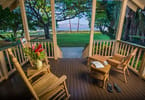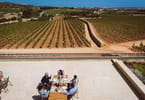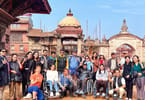France is spiffing up its sights and museums from the Rhine to the Pyrenees. Of course, the biggest news is in Paris, where 2010 brings important changes.
Many Parisian museums are renovating and tweaking offerings. Paris’ wonderful Picasso Museum has closed for a 30-month (some think longer) expansion. The Musee d’Orsay also is doing major renovations. At the Louvre, construction is under way on an Islamic Art wing, due to open in 2011. The pre-Classical Greek section is closed, and the Classical Greek pieces likely will be reorganized. The Army Museum’s recently renovated Arms and Uniforms section covers French military history from Louis XIV to Napoleon III. And for those who enjoy city vistas, you can now get a cheap escalator-only ticket at the Pompidou Center, skip the higher-priced museum, and ride the escalator directly to the top for the view.
Long lines are the norm at the Catacombs, where millions of skeletons unearthed from former Paris cemeteries have been neatly and eerily stacked, filling miles of tunnels from a medieval plaster of Paris quarry. Waits of 60 to 90 minutes are common. If you arrive later than 2:30 p.m., you may not get in. The Catacombs recently reopened after a spate of vandalism caused it to shut down. Security has been improved, and the loose skulls have been wired into place.
Versailles is wrapping up its multiyear renovation project, and all parts should be open. Though Europe’s greatest palace is the big draw, the vast royal park with the Domaine de Marie-Antoinette (the queen’s frilly rural escape) is attracting crowds too. Most of the palace is covered by the Paris Museum Pass (parismuseumpass.com), which for most travelers is a better deal than the LePasseport sold at the chateau and online (chateauversailles.fr).
Also outside Paris, Chartres’ cathedral is undergoing routine restoration. So, while the interior still will be divinely lit, mostly it will be scaffolding that is illuminated. At Giverny, Monet’s famous gardens now are open seven days a week April through October. Adjacent to his studio, what was the Museum of American Art has become the Museum of the Impressionists, showing temporary exhibits. Appropriately, the featured artist in 2010 is Monet.
The abbey island of Mont St. Michel has been a huge pilgrim attraction for centuries. A modern causeway made it easier to reach the island but also changed the flow of the tidal waters, causing the bay to slowly become marshland.
These days, plans to restore the abbey’s island status are moving ahead. Scheduled for completion in early 2010, the Couesnon River dam at the start of the causeway retains water upriver during high tide and releases it at low tide, in effect flushing the bay and keeping its famed mudflats muddy. In the future, the causeway will be realigned to meet a sleek foot bridge, and visitors will be shuttled from mainland parking lots to the bridge to walk the remaining 300 yards (over the water at high tide) to the island. The entire project is to be completed by 2014.
In the Loire, taking a bus or minivan excursion to see the valley’s beaucoup chateaux can save time (in line) and money (on admissions) when you buy your chateau ticket at a discounted group rate from the driver. Amboise’s tourist office now sells “le Pass,” which is tickets bundled in groups of three to save on entry fees. (Most Loire area tourist information offices offer some sort of pass promoting their sights.)
To avoid the lines at the popular Chateau de Chenonceau, purchase advance tickets at local tourist offices or from ticket machines. In the great castle town of Chinon, a free panoramic elevator now zips visitors up to the newly renovated fortress that crowns the city.
Along Provence’s Cotes du Rhone wine road, a trendy new winery called Domaine de Mourchon has become the buzz of the region, blending state-of-the-art technology and traditional winemaking methods — a dazzling ring of stainless-steel vats holds wines grown on land plowed by horses. The wines are winning international praise, and the owners are Scottish, eliminating the language barrier.
All these improvements to an already exciting tourist destination are a reminder that, more than ever, France is enthusiastic about sharing its heritage and welcoming visitors.
WHAT TO TAKE AWAY FROM THIS ARTICLE:
- In the future, the causeway will be realigned to meet a sleek foot bridge, and visitors will be shuttled from mainland parking lots to the bridge to walk the remaining 300 yards (over the water at high tide) to the island.
- Scheduled for completion in early 2010, the Couesnon River dam at the start of the causeway retains water upriver during high tide and releases it at low tide, in effect flushing the bay and keeping its famed mudflats muddy.
- In the Loire, taking a bus or minivan excursion to see the valley’s beaucoup chateaux can save time (in line) and money (on admissions) when you buy your chateau ticket at a discounted group rate from the driver.






















